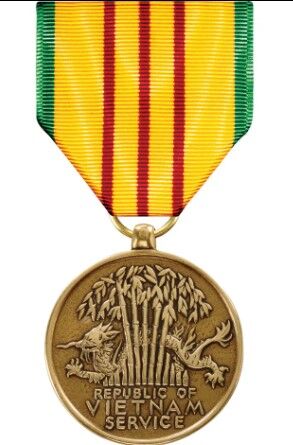This is the End: 50 years since US combat troops left Vietnam
Published 9:58 am Wednesday, March 29, 2023

- Vietnam Service Medal, awarded to U.S. troops who served in the area of the Vietnam War.
A half-century ago Wednesday, the last American combat troops left Vietnam, a war that had stretched over two decades.
On March 29, 1973, the final platoons of more than three million Americans who had served in the conflict left for American bases in South Vietnam, for ships offshore or bases in the Philippines. Since the U.S. inherited the leading Western role in the war from its former French allies in 1954, more than 58,200 Americans had died in Vietnam.
Oregon sent about 57,000 off to Vietnam. More than 710 were killed. Eighteen who died were from the Bend area.
That same day 50 years ago, North Vietnam turned over the last of 591 confirmed prisoners of war held by communist forces in Southeast Asia. The group included 325 Air Force and 138 Navy personnel, most of which were shot down over enemy targets. The returnees included 77 Army soldiers, 26 Marines and 25 civilians.
Air Force Capt. Ed Mechenbier had been held prisoner since 1967, when his F-4 Phantom was downed over enemy territory. On Feb. 18, he and several other POWs were taken to Hanoi’s Hanoi’s Gia Lam Airport, where they boarded an awaiting U.S. Air Force C-141 Starlifter.
”When we got airborne and the frailty of being a POW turned into the reality of freedom, we yelled, cried and cheered,” Mechenbier recounted in 2006 during a ceremony to commemorate the airlift at Wright-Patterson Air Force Base in Dayton, Ohio. He was a major general, the last of the 80% of captured air crews to remain in the military following the Vietnam War.
The remains of more than 1,000 Americans originally listed as missing in action during the Vietnam War have been identified and returned to their families for burial over the past 50 years, most often with full military honors.
The Defense POW/MIA Accounting Agency and civilian volunteer groups continue to look for several hundred others who have not been located. Benny Dexter was a 21-year-old Air Force technical sergeant driving a jeep north of Saigon when he was captured by Viet Cong forces on May 9, 1966. He was never seen again. His family can’t properly grieve his loss, including his sister, Dollie Dexter Raymond, of Redmond.
“These people can not go to a cemetery and lay a wreath on a grave,” Army Lt. Col. Dick Tobiason of Bend, said during a POW/MIA Recognition Day ceremony in 2019.
May 29 was officially designated National Vietnam War Veterans Day in 2017. It honors those who served, died, were wounded, were missing in action, or gave support to the American effort.
Inheriting a war
Nazi Germany had captured France in 1940 during World War II. Free French forces under Gen. Charles de Gaulle, fought on the side of American, British, Russian and other allied forces. After the war, France wanted its colonies in “French Indochina” that had fallen under Japanese control. The area included Vietnam, Cambodia and Laos.
Many Vietnamese, some of whom actively fought Japan under the leadership of Ho Chi Minh, sought independence. When the French tried to reassert colonial rule, war broke out that culminated in the withdrawal of France in 1954. Vietnam was divided between the communist North and pro-American South.
For the United States, what started out as an advisory role to the South Vietnamese military morphed over the years into a massive combat role requiring the drafting of new U.S. troops to fight. The first U.S. war death was recorded in 1956. The death toll rose slowly until 1964, when President Lyndon B. Johnson asked Congress to expand the American rule under the Gulf of Tonkin Resolution. U.S. Sen. Wayne Morse, D-Oregon, was one of only two “no” votes among the 100 senators.
”Trying by indirection to obtain congressional approval of our illegal, unilateral military action in South Vietnam without coming forward with a request for a declaration of war,” Morse said during the debate.
Morse lost his 1968 bid for a fourth term in the U.S. Senate, losing by 3,500 votes to State Rep. Robert Packwood, a Republican.
North Vietnam launched the bloody but failed Tet Offensive in 1968. While American and South Vietnamese troops won the battle, the public in the United States was increasingly questioning the worth of a war that was requiring an unpopular draft to maintain 500,000 troops in Vietnam. The Tet Offensive spiked the body count, with 16,899 Americans killed that year.
‘Peace with honor’
Republican Richard Nixon was elected president in 1968 over Hubert Humphrey, the Democrat who served as vice-president under President Lyndon B. Johnson.
Nixon said he had plans for how to get the United States out of the conflict with “peace through honor.”
Nixon assured conservatives in Congress, “war hawks,” that he wouldn’t capitulate to “doves” among lawmakers who wanted troops home immediately. It would still be years until that day would come.
The “Paris Peace Accords” concluded with the “Agreement on Ending the War and Restoring Peace in Vietnam” that was signed on Jan. 27, 1973.
Using heavy air transports and ships, the Americans and allied troops, notably South Korean, turned over their equipment and bases to the South Vietnamese and went home.
Any thoughts of reconciliation and concord disappeared between the two Vietnams and combat soon resumed, with Hanoi eventually using 30 regular army divisions, alongside masses of Viet Cong guerillas in the south, to topple the Saigon government and capture the capital in April 1975.





